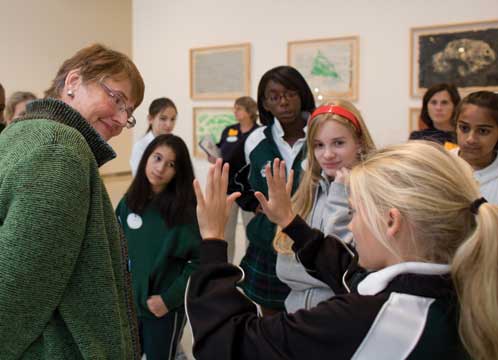 Winter 2008
Winter 2008|
“Many of our tour participants for Life on Mars are on their second visit…because they know they can get more out of an exhibition of this magnitude guided by someone with knowledge about the art and the artists.”
- Mary Ewalt
|
When my sister and I toured the Carnegie International together, she confessed, “I know these artists are saying something to me, but I’m not sure I can hear it.” She’s not alone. During our many tours, my fellow docents and I often hear comments like “I don’t get this at all.” And participants often seem terrified that the docent will expect some kind of art analysis from them. But there’s nothing scary about a docent-led tour at Carnegie Museum of Art. Quite the opposite. Many of our tour participants for Life on Mars, the 2008 Carnegie International are on their second visit, and they returned for a tour because they know they can get more out of an exhibition of this magnitude guided by someone with knowledge about the art and the artists. And they’re right. In the months leading up to a show’s opening, docents put in countless hours of training at the mu-seum, home study, and gallery time. Visitors seem to enjoy docents who offer a personalized and interactive approach to the sometimes confounding contemporary art included in the International. And it’s our genuine pleasure to be able to react personally to the ideas presented by the artists, discuss the challenging art, and then have visitors do the same. We’ve heard many different responses to individual artists. Upon learning that Richard Hughes’ instal-lation would simply be dismantled, one visitor wanted to take it home. Another wondered aloud, “Is this art on the wall or in my head?” Many were intrigued by Andro Wekua’s Get Out of My Room and asked if it was even a work of art at all. Thomas Hirshhorn’s Cavemanman has proven to be fascinating to visitors. Mark Bradford’s large paintings have drawn such close examination of his techniques that docents have had to restrain visitors from touching the artwork. Rivane Neuenschwander’s I Wish Your Wish consistently attracts attention from students and adults who spend time reading wishes, writing their own, and collecting strips of ribbons to wear home. In addition to leading adults on tours, many docents have the joy of introducing students to the exhibition, often with very specific, teacher-defined goals. I particularly enjoyed touring a group of 10th graders who had just read August Wilson’s Fences (the Pulitzer Prize-winning play about blacks in the pre-civil-rights era). By discussing works such as Matthew Monahan’s large statues, the students began to see emotional and physical barriers depicted in the art: “Are they trying to get out, or are those straps holding them together?” After the tour, many students wrote blogs, which I read with great satisfaction. When a group of 8th graders visited Haegue Yang’s room installation, one student felt as if he had gone “inside a kaleidoscope.” And a 5th grader thought that the silver foil figures in Cavemanman “were fragile and needed support from books to survive.” Merle Culley, a fellow docent, loves doing ‘Art Inspires Narrative Writing’ tours in the International because, she says, they are “such a fertile ground for ideas and creativity.” On occasion, docents provide tours to specialized museum groups. Residents of a senior-care facility, most of them Alzheimer’s patients, were refreshingly engaged by Life on Mars, without frustration or confusion. Their docent told me her goal was to help them stay “in the moment.” “How pretty!” they repeated about Ranjani Shettar’s beautiful and compelling room installation. A group from a youth center working on building a public sculpture came to Life on Mars with their program’s artist in residence. The artist, exhibition curator Douglas Fogle, and docent Marilyn Finberg showed the young men works by Hirschhorn, Bradford, Mike Kelley, Apichatpong Weerasethakul, and Barry McGee that they had researched in the exhibition’s gallery guide before the visit. Their experience was so positive that they plan to return. Amanda Matta, a participant in the museum’s university docent program, had a particularly memorable experience when she was asked by two computer engineers from California to walk them through the exhibition. They were in town for a meeting at Carnegie Mellon. “They were interested in knowing more about the processes of creating the art and the materials that went into each piece, and they were so excited and engaged,” she said. “I found myself learning from them!” |
Darwin’s Big Bang: 150 Years Later · Paging Doctor Darwin · The Horse · 1958 · Director's Note · NewsWorthy · Now Showing · Face Time: Eric C. Shiner · Artistic License: Inside a Fantastical Mind · About Town: A Wild Weather Adventure · Science & Nature: All Hail the Telescope · Another Look: Andy Warhol's Time Capsules
 |
Copyright © 2017 CARNEGIE Magazine. All rights reserved. |

